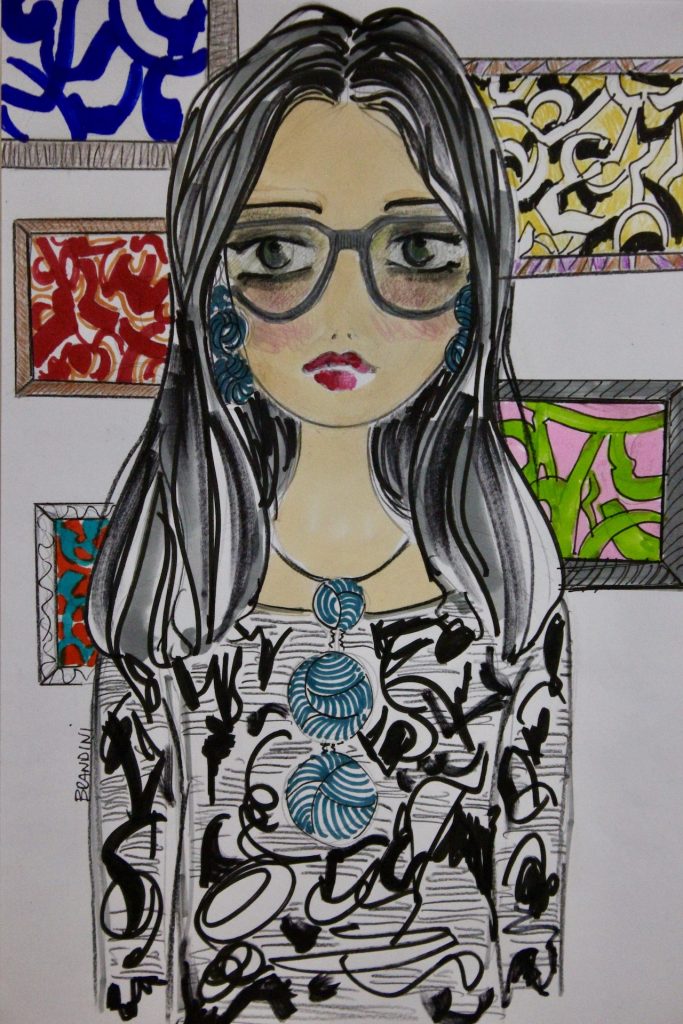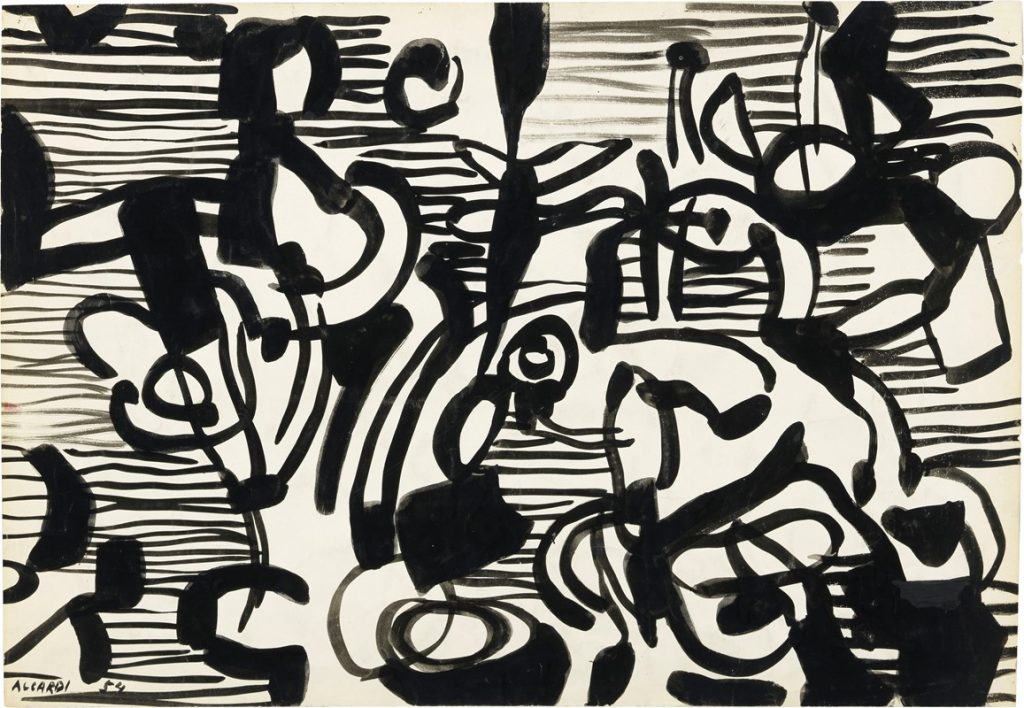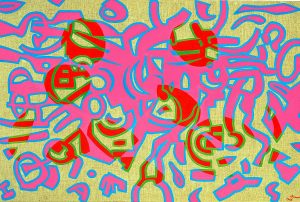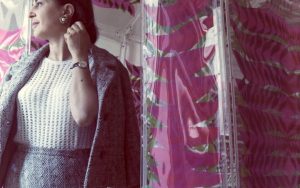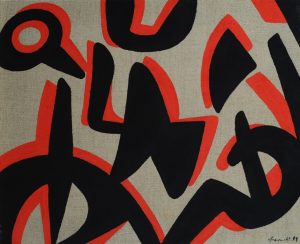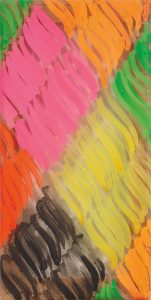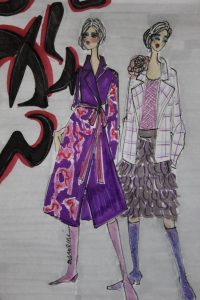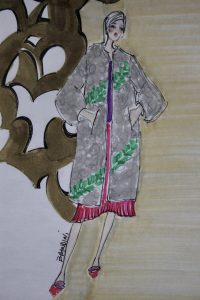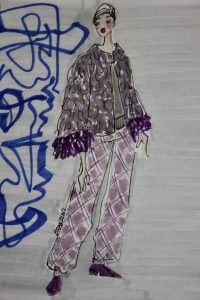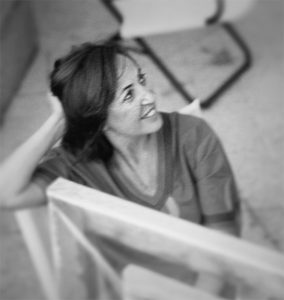Antonella, the curator of the exhibition, by Beatrice Brandini
Carla Accardi: Untitled, 1954
Carla Accardi was the pioneer of abstract art (a magnificent forerunner), but above all one of the few women in a world dominated by men. Feminist, innovator, creative, free.
A work by Carla Accardi
Accardi was born in Trapani, daughter of an engineer and a noblewoman, she immediately distances herself from the “province” to land in Rome where she will settle until her death. Very precocious in her passion for drawing, it is said that the first portrait of her was done at the age of 11, the first self-portrait at 16.
She supported by her father, who senses her talent, she goes to study in Florence, where however she gets bored, rebelling against the fashion of figurative painting. In fact in those years the great painters such as Casorati, Campigli, Sironi, De Chirico, were all figurative, after all Florence, the cradle of the Renaissance, with its Botticelli, Beato Angelico or Michelangelo, certainly could not make an exception, but rather it was the ideal stage for this artistic expression.
Carla Accardi in 1966 with her “tents”
It will be by browsing what is happening outside Italy to bring Accardi closer to the new avant-gardes, admiring Mondrian, Klee, Kandinsky but above all Matisse.
However, her first abstract works are not immune from criticism and disputes, the first detractors are the critics of the PCI (Communist Party), to which she and her husband Sanfilippo were members, but also illustrious authors such as Renato Guttuso, who defines her first important work “Decompositions”, a doodle.
Carla Accardi: Piccoli Settori, 1962
In 1947 she is one of the founders of the Forma 1 group, with Attardi, Consagra, Dorazio, Perilli, Turcato and Sanfilippo (the latter will become her husband two years later). The members of the group define themselves as “formalists and Marxists”, as opposed to the realist part of the New Front of the Arts, led by Renato Guttuso.
In 1948 she took part in the XXIV Venice Biennale, and in the following years there were her first personal exhibitions in Italy. In 1953 her painting undergoes an evolution, a change towards the poetics of the sign, in 1954 an important meeting, the one with the French critic Michel Tapié, will consecrate her, making her exhibit outside the Italian borders, in Paris for example, together with personalities like Burri or Fontana.
Carla Accardi: Nerorosso, 1994
In the fifties, in full informal atmosphere, Accardi creates compositions with defined and circumscribed signs, with clear colors, sometimes simply in black and white.
In the following years she will be a riot of successes, she exhibits in New York, in London, in 1964 she will exhibit at the XXXVII Venice Biennale with a personal room. Her technique begins to change, in truth it had never been “traditional”, since she had already renounced easel and palette to express herself by placing the canvases on a table or on the floor.
Carla Accardi: Mixed Colors, varnish on sicofoil
“…. my painting cannot stop on a problem, pose it and define it once and for all. I like to revolve around this problem, see its different possible solutions, be coherent and, at the same time, able to change ”. Carla Accardi
With the economic boom and the advent of designers, Accardi experiments again, she discovers sycofoils, a magical polymer that gives brightness to her paintings. With sycofoil she creates three-dimensional objects, the famous “curtains”, ancestors of poor art.
Carla Accardi: D’altri bui di viola, 1990
From the Eighties until her death, one cannot count the retrospectives, the personal ones, the anthologies dedicated to Accardi. In 2006 her works are exhibited in New York at the Sperone Westwater Gallery together with those of Lucio Fontana.
But her indisputable talent didn’t stop at creation; was a pioneer for women’s rights, in years in which bringing her students to a debate on women’s emancipation (she taught art history at the Papini high school in Rome) cost her her job and a disciplinary measure, such to be repudiated by all the schools of the Republic (it was the seventies, not the Middle Ages!).
Three sketches with dresses that maybe Carla would have liked today. By Beatrice Brandini
She was also a very elegant woman, never with a hair out of place, demonstrating that elegance and beauty should not be mortified by virtue of the credibility of a woman and an artist.
A portrait of Carla Accardi
Accardi, with her work, her emancipation and her freedom, gave women a voice on revolutionary topics, such as that of gender equality which for those years was truly a utopia.
Thanks Carla for your beauty and for your message to us women.
Good life to everyone!
Beatrice


